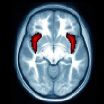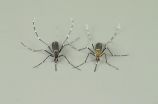(Press-News.org) In school-age children previously diagnosed with depression as preschoolers, a key brain region involved in emotion is smaller than in their peers who were not depressed, scientists have shown.
The research, by a team at Washington University School of Medicine in St. Louis, also suggests that the size of the brain's right anterior insula may predict the risk of future bouts of depression, potentially giving researchers an anatomical marker to identify those at high risk for recurrence.
The study is published online Nov. 12 in the journal JAMA Psychiatry.
There is one insula on each side of the brain, and they are thought to be involved in emotion, perception, self-awareness and cognitive function.
The insula also is smaller in depressed adults compared with those of their peers who are not depressed. By using MRI scans and focusing on brain anatomy, the researchers hope to find clues to better diagnose and treat depression and to identify individuals at higher risk for recurrent episodes.
As part of the study, the investigators also found the same brain structure is smaller in kids diagnosed with pathological guilt during their preschool years, providing evidence that excessive guilt is a symptom of depression related to the size of the insula.
"That's not a complete surprise because for many years now, excessive guilt has consistently been a predictor of depression and a major outcome related to being depressed," said first author Andrew C. Belden, PhD.
Pathological guilt can be a symptom of clinical depression, as well as other psychiatric disorders including anxiety, obsessive-compulsive disorder and bipolar disorder. Belden, an assistant professor of child psychiatry, said it's relatively easy to spot the problem in children because they excessively blame themselves for things they've done -- and haven't done.
"A child with pathological guilt can walk into a room and see a broken lamp, for example, and even if the child didn't break it, he or she will start apologizing," Belden explained. "Even after being told he or she is not at fault, the child will continue to apologize and feel bad."
The "million-dollar question," he said, is whether depressed children become more prone to guilt or guilt-prone children are more likely to become depressed. Either way, Belden said, the discovery that pathological guilt is related to changes in the brain that increase the risk for recurrent depression could be a major step in better understanding the trajectory of depression.
The researchers followed a group of children in the Preschool Depression Study, conducted by investigators led by Joan L. Luby, MD, director of Washington University School of Medicine's Early Emotional Development Program. The children were assessed for depression and guilt each year from ages 3-6.
There were 47 diagnosed with depression as preschoolers, and 82 who had not been depressed. Some 55 percent of those with depression had displayed pathological guilt as preschoolers, while 20 percent of the nondepressed group had excessive guilt.
All of the children also had MRI brain scans about every 18 months from ages 7-13.
The researchers found that children with a smaller insula in the right hemisphere of the brain -- related either to depression or excessive guilt -- were more likely to have recurrent episodes of clinical depression as they got older.
"Arguably, our findings would suggest that guilt early in life predicts insula shrinkage," Belden said. "I think the story is beginning to emerge that depression may predict changes in the brain, and these brain changes predict risk for recurrence."
The research suggests that excessive guilt and depression may put preschoolers on a developmental trajectory that contributes to problems with depression later in childhood and even throughout life. Some children experience depression, recover and never have another episode, but others experience a chronic and relapsing course. Belden said it is important to identify those who are at risk for chronic and relapsing depression.
A previous study from the same group found that children diagnosed with depression as preschoolers were 2.5 times more likely to be clinically depressed in elementary and middle school than kids who were not depressed in preschool.
AUDIO:
Child psychiatry researchers at Washington University School of Medicine in St. Louis have found that a brain region involved in emotion is smaller in children who had clinical depression when...
Click here for more information.
The research team would like to continue the study for at least five more years. During that time frame, study subjects will pass through the high-risk period of adolescence.
"We're hoping to follow these children for several more years, perhaps even into adulthood," Belden said. "On the immediate horizon is a look at the effects of some things that become more common during adolescent years as kids hit a high-risk time for substance and alcohol abuse and other problems that often co-exist with clinical depression. We want to see how those sorts of issues affect these children we've been following since preschool."
INFORMATION:
Funded by the National Institute of Mental Health (NIMH) of the National Institutes of Health (NIH). NIH grant numbers: 2R01 MH064769-06A1, PA-07-070NIMH R01 and 5K01MH090515-04.
Belden AC, Barch DM, Oakberg TJ, April LM, Harms MP, Botteron KN, Luby JL. Anterior insula volume and guilt: neurobehavioral markers of recurrence after early childhood major depressive disorder. JAMA Psychiatry, Online First. Published online Nov. 12, 2014.
Washington University School of Medicine's 2,100 employed and volunteer faculty physicians also are the medical staff of Barnes-Jewish and St. Louis Children's hospitals. The School of Medicine is one of the leading medical research, teaching and patient-care institutions in the nation, currently ranked sixth in the nation by U.S. News & World Report. Through its affiliations with Barnes-Jewish and St. Louis Children's hospitals, the School of Medicine is linked to BJC HealthCare.
One of the world's deadliest mosquitoes sustains its taste for human blood thanks in part to a genetic tweak that makes it more sensitive to human odor, according to new research.
Researchers report in the journal Nature that the yellow fever mosquito contains a version of an odor-detecting gene in its antennae that is highly attuned to sulcatone, a compound prevalent in human odor. The researchers found that the gene, AaegOr4, is more abundant and more sensitive in the human-preferring "domestic" form of the yellow fever mosquito than in its ancestral "forest" form that ...
Adding tiny amounts of vegetable puree to milk and then rice at the time of weaning makes children more likely to eat vegetables, new University of Leeds research shows.
Infants who consumed either milk (breast milk or formula) followed by rice mixed with vegetable puree ate nearly half as many vegetables again as infants who ate just milk followed by baby rice.
Professor Marion Hetherington, of the School of Psychology at the University of Leeds, led the study. She said: "We took inspiration from French mothers, as previous studies in this area have shown that they ...
(SACRAMENTO, Calif.) -- In its first clinical application in pediatric patients, an investigational medication developed and manufactured at UC Davis has been found to effectively treat children with life-threatening and difficult-to-control epileptic seizures without side effects, according to a research report by scientists at UC Davis and Northwestern University.
The investigational formulation of allopregnanolone was manufactured by UC Davis Health System's Good Manufacturing Practice Laboratory. Two children were treated with the allopregnanolone formulation, one ...
LA JOLLA, CA - November 12, 2014 - Driving to work becomes routine--but could you drive the entire way in reverse gear? Humans, like many animals, are accustomed to seeing objects pass behind us as we go forward. Moving backwards feels unnatural.
In a new study, scientists from The Scripps Research Institute (TSRI) reveal that moving forward actually trains the brain to perceive the world normally. The findings also show that the relationship between neurons in the eye and the brain is more complicated than previously thought--in fact, the order in which we see things ...
(MEMPHIS, Tenn. - November 12, 2014) An international collaboration has identified frequent mutations in two genes that often occur together in Ewing sarcoma (EWS) and that define a subtype of the cancer associated with reduced survival. The research, conducted by the St. Jude Children's Research Hospital-Washington University Pediatric Cancer Genome Project and the Institut Curie-Inserm through the International Cancer Genome Consortium, appears in the current issue of the scientific journal Cancer Discovery.
Mutations in the genes STAG2 and TP53 have previously been ...
Giant otters may have a vocal repertoire with 22 distinct vocalization types produced by adults and 11 neonate vocalization types, according to a study published November 12, 2014 in the open-access journal PLOS ONE by Christina Mumm and Mirjam Knörnschild from University of Ulm, Germany.
Giant otters, found in South America, are very social and frequently vocalizing animals. They live in groups that may vary, but generally include a reproductive pair and their offspring, born in different years. Individuals engage in shared group activities and hold different social ...
Using fewer than twenty genomes, researchers were unable to find rare protein-altering variants significantly associated with extreme longevity, according to a study published November 12, 2014 in the open-access journal PLOS ONE by Hinco Gierman from Stanford University and colleagues.
Supercentenarians are the world's oldest people, living beyond 110 years of age. Seventy-four are alive worldwide, with twenty-two living in the United States. The authors of this study performed whole-genome sequencing on 17 supercentenarians to explore the genetic basis underlying ...
An educational approach in kindergarten focused on the development of executive functions--the ability to avoid distractions, focus attention, hold relevant details in working memory, and regulate impulsive behavior--in children improved academic learning in and beyond kindergarten, helping to overcome deficits in school readiness associated with poverty, according to a study published November 12, 2014 in the open-access journal PLOS ONE by Clancy Blair and C. Cybele Raver from New York University.
Based on the results, the authors suggest that executive function ...
An educational approach focused on the development of children's executive functions - the ability to avoid distractions, focus attention, hold relevant information in working memory, and regulate impulsive behavior - improved academic learning in and beyond kindergarten, according to a new study by researchers at NYU's Steinhardt School of Culture, Education, and Human Development.
Because some effects were especially pronounced in high-poverty schools, the findings hold promise for closing the poverty-related achievement gap and suggest that an emphasis on executive ...
The normally bland face of Uranus has become increasingly stormy, with enormous cloud systems so bright that for the first time ever, amateur astronomers are able to see details in the planet's hazy blue-green atmosphere.
"The weather on Uranus is incredibly active," said Imke de Pater, professor and chair of astronomy at the University of California, Berkeley, and leader of the team that first noticed the activity when observing the planet with adaptive optics on the W. M. Keck II Telescope in Hawaii.
"This type of activity would have been expected in 2007, when Uranus's ...




